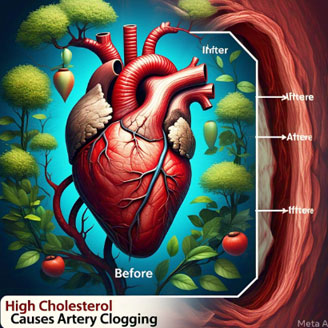Understanding Cholesterol: The Good vs. The Bad
As a diabetologist in Mumbai, I often talk to my patients about the importance of managing cholesterol. But many people are confused about what cholesterol really is and why it matters. Is all cholesterol bad? Not really! In fact, your body needs some cholesterol to function properly. The key is understanding the difference between “good” and “bad” cholesterol—and how to keep them in balance. Let’s break it down in simple terms.

What is Cholesterol?
Cholesterol is a waxy, fat-like substance found in your blood. It’s not all bad—your body needs it to build cells, produce hormones, and digest food. However, too much of the wrong kind of cholesterol can increase your risk of heart disease, stroke, and other health problems.
The Good vs. The Bad
Cholesterol travels through your bloodstream in tiny packages called lipoproteins. There are two main types:
1. HDL (High-Density Lipoprotein) – The Good Cholesterol
- HDL is like a cleanup crew. It picks up excess cholesterol from your blood and takes it back to your liver, where it’s removed from your body.
- Higher HDL levels are linked to a lower risk of heart disease.
2. LDL (Low-Density Lipoprotein) – The Bad Cholesterol
- LDL is the troublemaker. It carries cholesterol to your arteries, where it can build up and form plaques. These plaques can narrow or block your arteries, leading to heart attacks or strokes.
- Lower LDL levels are better for your heart health.
Why Cholesterol Matters for Diabetics
If you have diabetes, managing cholesterol is even more important. High blood sugar levels can damage your blood vessels and increase LDL cholesterol, raising your risk of heart disease. In fact, heart disease is one of the leading complications of diabetes. Keeping your cholesterol in check is a crucial part of staying healthy.
5 Signs Your Cholesterol Might Be Out of Balance
- Chest pain or discomfort (a sign of blocked arteries).
- Fatigue or shortness of breath (due to reduced blood flow).
- High blood pressure (often linked to high LDL levels).
- Yellowish deposits on your skin (called xanthomas, caused by high cholesterol).
- A family history of high cholesterol or heart disease.

How to Keep Your Cholesterol in Check
The good news? You can improve your cholesterol levels with simple lifestyle changes:
1. Eat Heart-Healthy Foods
- Include: Fruits, vegetables, whole grains, nuts, seeds, and fatty fish like salmon.
- Avoid: Fried foods, processed snacks, and foods high in trans fats and saturated fats.
2. Get Moving
Regular exercise can raise HDL (good cholesterol) and lower LDL (bad cholesterol). Aim for at least 30 minutes of moderate activity, like walking or cycling, most days of the week.
3. Quit Smoking
Smoking lowers HDL and damages your blood vessels, making it easier for cholesterol to build up.
4. Maintain a Healthy Weight
Losing even a small amount of weight can improve your cholesterol levels and reduce your risk of heart disease.
5. Monitor Regularly
If you have diabetes or a family history of high cholesterol, get your cholesterol levels checked regularly. A simple blood test can tell you where you stand.
Why This Matters for Mumbaikars
In a bustling city like Mumbai, where fast food and busy schedules are the norm, it’s easy to overlook cholesterol levels. But heart disease is a leading cause of death in India, and managing cholesterol is one of the best ways to protect your heart. Whether you’re young or old, diabetic or not, keeping your cholesterol in check is essential for a healthy life.
Final Thoughts
Cholesterol isn’t something to fear—it’s something to understand. By knowing the difference between good and bad cholesterol and taking steps to keep them balanced, you can protect your heart and overall health. Small changes in your diet, exercise, and lifestyle can make a big difference.
Feel free to share this blog with friends and family. If you have questions or need personalized advice, don’t hesitate to reach out. Let’s work together to keep Mumbai healthy and heart-smart!
